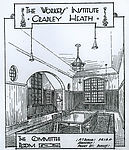 Architect's drawing of the Committee Room
Architect's drawing of the Committee Room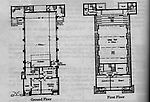 Architect's floor plans
Architect's floor plans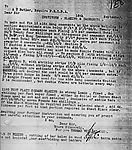 Quote from TW Camm for glazing and casements, September 1911
Quote from TW Camm for glazing and casements, September 1911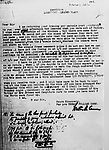 Letter to the architect from TW Camm concerning work in progress on the glazing and casements, February 1912
Letter to the architect from TW Camm concerning work in progress on the glazing and casements, February 1912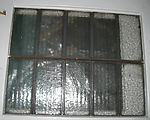 Photograph of the original glazing prior to dismantling
Photograph of the original glazing prior to dismantling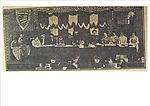 Representatives of the National Federation of Women Workers on stage at the Institute
Representatives of the National Federation of Women Workers on stage at the Institute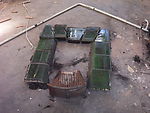 Jigsaw style fireplace
Jigsaw style fireplace Door handle
Door handle

Some of the Institute's original interior fixtures and fittings have fallen victim to modernisation and vandalism. However, many have survived, as identified in an Historic Building survey, carried out, in 2001, on behalf of Sandwell MBC. Original photographs and architect's drawings have helped the Museum to recreate the building as it would have been in the 1930s.
The fixtures and fittings chosen for the Institute were the very best of modern design. The electrical work was carried out by E.C. Theedam & Co. Light switches were made from bakelite, an early form of plastic developed in 1910. A panel of six such bakelite switches was found in the General Office.
Although there is little evidence to suggest who supplied the light fittings, catalogues of the time provide some clues. Light fittings very similar to those shown in the architect's drawings can be found in catalogues of both the Birmingham Guild of Handicraft Ltd. and B Verity and Sons
The architect's drawing of the committee room shows a central electrolier and four pendants. The bulbs in the electrolier were left unshaded. This implies that the bulbs used were carbon filament, which did not give off a bright light. The use of a shade would have limited the light even further. The lamp shades of the pendants were probably polished copper or brass. Some of the rooms may well have needed wall lights to give a stronger light.
It is most likely that electrical wall sockets were not fitted originally, as electrical appliances were in the early stages of development, and were still quite rare in 1912. Appliances existing at the time tended to be fitted with a bayonet style plug, which could be plugged into overhead light fittings.
The Institute was heated with a hot water system, fitted and maintained between 1912 and 1928 by Lucas & Son. The system was located in the basement next to the kitchen. Some of the rooms have also retained their original fireplaces. A green tiled ‘jigsaw’ surround found in one of the rooms is a typical example of Arts and Crafts style. A similar one can be seen at Blackwell, the Arts and Crafts House in Cumbria.
The windows in the Institute were leaded lights, a typical feature of Arts and Crafts design. Many of the interior doors were found to retain the original glazing. The glass used in the doors and lower windows would have been obscurity glass to give some privacy to the rooms. The glazing company contracted to do the work at the Institute was T.W. Camm, although you will notice that it is listed as T.J. Camm in the opening ceremony booklet. We assume that this is a printing error.
The Camm family owned two glazing companies. Thomas William Camm ran one himself and his brothers, John Matthew and Henry Charles, set up another as Camm & Co. Both were based in Smethwick. Thomas’ children carried on his business following his death in 1912. The business continued to be strongly influenced by the Arts and Crafts Movement. Camm’s windows can still be seen all over the world, including in many of this country's churches. The letters show correspondence between Camm and the architect, AT Butler, regarding the windows. One letter includes some bargaining regarding the price of windows and casements and the other some more specific technical detail.
Viner and Son were responsible for the decoration of the Workers' Institute from 1912 until 1968. We know from the opening ceremony booklet that the main hall was left as exposed narrow bricks with striking white grout between. The other rooms were plastered and painted, although we have no record of what colours or shades were used. Interior and exterior woodwork was painted or stained green. The ironwork of the exposed roof structure was painted golden bronze, which would probably have matched the light fittings.
Some of the original doors are still fitted with Arts and Crafts door handles. They are of a rustic Suffolk latch design, but operate a spring latch not bar, as is more usual. They are made of a bronze coloured metal, which ties in with the light fittings and exposed iron work.
Rollover the captions in the box to see the available images in thumbnail format, click the caption to see the full-size image
| Reference: | 697 |
| Keywords: | |
| Archive Ref: | |
| Updated: | Wed 25 Jun 2008 - 1 |
| Interpretation written by | Jenny Ermoyenous |
| Author's organisation | Curatorial |
| Organisation's website | |
| Source | Unknown Pess cutting - photograph of Stage 1912 |